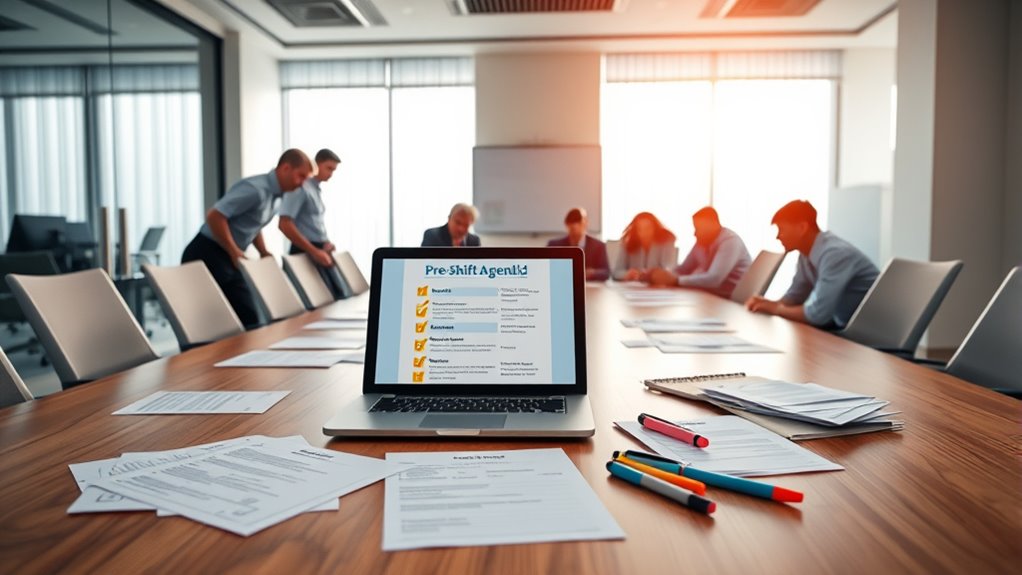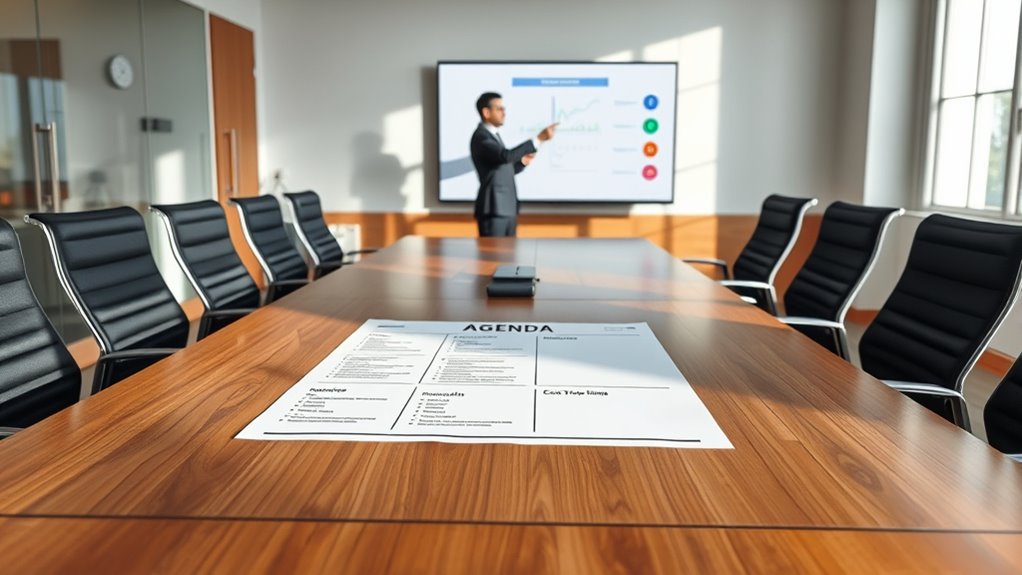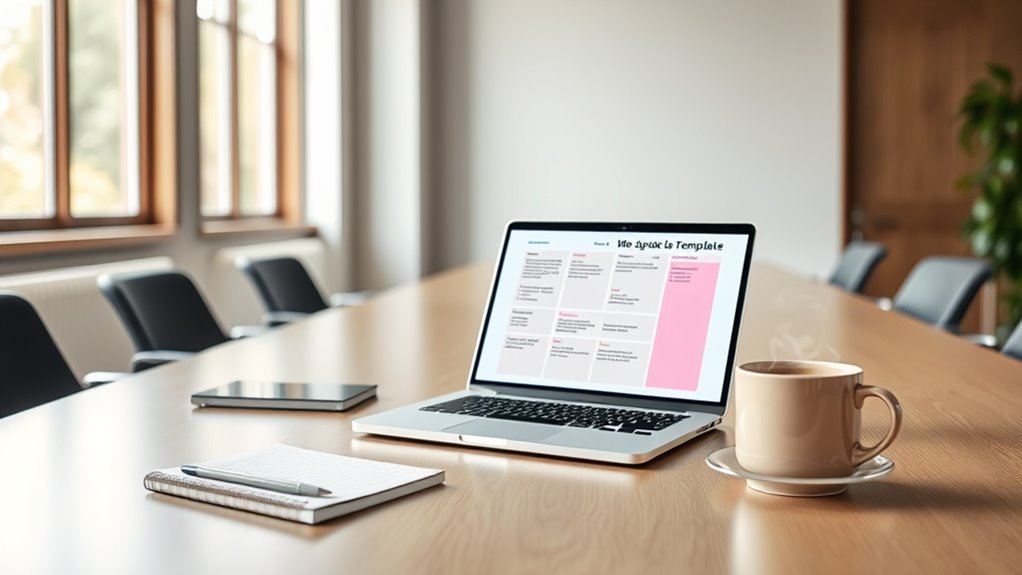An effective pre-shift meeting begins with a clear, structured agenda that aligns your team’s goals, safety updates, and important tasks. Prioritize critical topics, set time limits, and assign roles like a note-taker or timekeeper to stay focused. Use visual aids or interactive elements to boost engagement. Continuously improve by gathering feedback and tracking key metrics. Keep these principles in mind, and you’ll create efficient, impactful meetings—more tips await if you continue exploring.
Key Takeaways
- Prepare a clear, concise agenda highlighting meeting objectives, key topics, and time allocations to ensure focused discussions.
- Define specific goals, review safety updates, and outline shift responsibilities to align team expectations effectively.
- Assign roles such as timekeeper and note-taker to maintain structure and maximize meeting productivity.
- Incorporate visual aids, interactive questions, and tailored communication strategies to boost engagement and understanding.
- Regularly review meeting processes, gather feedback, and adjust agenda and timing to continuously improve effectiveness.
The Importance of Structured Pre-Shift Meetings

Structured pre-shift meetings are essential because they guarantee everyone is on the same page before starting work. When you hold these meetings, you set clear expectations, which helps prevent misunderstandings and mistakes during the shift. They give you a chance to communicate important updates, safety protocols, and specific goals for the team. By establishing a routine, you foster accountability and ensure that all team members are aware of their responsibilities. This preparation boosts morale and promotes a sense of teamwork, making the entire operation run more smoothly. Without structure, information can be overlooked or misunderstood, leading to errors and inefficiencies. A well-organized pre-shift meeting keeps everyone aligned, focused, and ready to perform at their best from the moment the shift begins.
Key Components of an Effective Agenda

To make your pre-shift meetings effective, you need a clear agenda that sets specific objectives. Allocate time wisely to cover key discussion topics without rushing or dragging. Focusing on these components guarantees everyone stays aligned and the meeting runs smoothly. Incorporating insights from AI in Business can also help identify areas for process improvement and optimize overall team performance.
Clear Objectives
Clear objectives are the foundation of an effective agenda because they set focused expectations for the meeting. When you define clear goals, everyone knows what needs to be accomplished, preventing wasted time and confusion. Your objectives should be specific, measurable, and relevant to the shift’s needs. For example, rather than saying “discuss sales,” specify “review yesterday’s sales figures and identify areas for improvement.” This clarity helps team members prepare and stay on track. Well-defined objectives also enable you to evaluate whether the meeting was successful afterward. Keep your objectives concise and aligned with your team’s priorities. When everyone understands the purpose from the start, your pre-shift meeting becomes more productive and focused. Incorporating sound healing science principles can also enhance focus and relaxation during the meeting.
Time Allocation
Effective time allocation guarantees that each part of your pre-shift meeting serves a purpose and fits within the allotted schedule. You should set clear time limits for each segment, ensuring you stay on track and avoid overruns. Prioritize critical topics, giving them adequate discussion time, while less urgent items receive shorter attention. Use a timer or watch to keep everyone aware of time constraints. This approach prevents the meeting from dragging on and helps maintain focus. When planning, be realistic about how long each topic takes, including questions or clarifications. Remember, efficient time use keeps your team engaged and ensures all essential points are covered without rushing. Proper time allocation makes your pre-shift meeting productive and respectful of everyone’s schedule. Additionally, understanding software development lifecycle (SDLC) helps in planning meeting content that aligns with project phases and quality assurance objectives.
Key Discussion Topics
What are the essential topics you need to cover to guarantee your pre-shift meeting is thorough and productive? First, review safety protocols and any recent incident updates to make sure everyone stays vigilant. Discuss daily operational goals and clarify individual responsibilities so team members understand their tasks. Address inventory levels, equipment needs, and potential issues that could impact the shift. It’s also helpful to review customer expectations, special orders, or service concerns. Additionally, consider incorporating simple recipes like homemade flautas or flavorful appetizers to boost team morale and foster a positive environment. Finally, encourage open communication by inviting team members to share concerns or suggestions. Covering these topics ensures everyone is aligned, informed, and prepared. A focused discussion on these key points creates a smooth handover, minimizes misunderstandings, and sets the tone for an efficient, safe, and successful shift.
Customizing Your Agenda Template for Different Teams

To make your pre-shift agenda truly effective, you need to tailor it to each team’s priorities and responsibilities. Consider their specific tasks and roles, and adapt the agenda items accordingly. Also, pay attention to how your teams prefer to communicate to ensure the meeting stays engaging and productive. Incorporating performance improvement strategies can further enhance the effectiveness of your meetings and align team efforts with tuning best practices.
Team-Specific Priorities
Have you ever wondered how to make pre-shift meetings more relevant to each team’s unique goals? The key is to identify and highlight team-specific priorities. Before the meeting, review recent performance data and project updates to understand what matters most to each team. During the meeting, focus on these priorities by discussing upcoming tasks, challenges, and goals relevant to that team’s responsibilities. Encourage team members to voice their concerns and ideas related to their specific objectives. Tailoring the agenda ensures the team stays aligned and motivated, knowing their efforts directly impact their goals. Additionally, being aware of signs of spoilage in related materials can help maintain a safe and healthy work environment. This targeted approach fosters better engagement and accountability, making the meeting meaningful and productive for everyone involved.
Role-Dependent Tasks
Building on the idea of team-specific priorities, tailoring your agenda template to reflect role-dependent tasks guarantees each team’s unique responsibilities are addressed effectively. You can do this by clearly outlining tasks specific to each role, ensuring everyone knows their focus areas. For example:
- Assign safety checks for maintenance staff
- Highlight customer service updates for front-line team members
- Include inventory updates for stockroom personnel
- Outline technical troubleshooting for IT staff
- Incorporate decorative elements that reflect the overall theme and boost team morale during meetings
This customization helps prevent confusion and keeps the meeting relevant for all participants. When roles are clearly defined, team members stay engaged and understand how their work contributes to the overall shift. Adjusting your agenda for role-dependent tasks creates a streamlined, efficient meeting that respects each team member’s expertise and responsibilities.
Communication Preferences
How do communication preferences vary among different teams, and why is it important to customize your agenda accordingly? Some teams prefer quick messages or emails, while others favor face-to-face updates or instant messaging. Recognizing these differences ensures your meeting remains effective and engaging. For example:
| Team Type | Preferred Communication Method |
|---|---|
| Remote Teams | Video calls or instant messages |
| On-site Teams | In-person discussions |
| Creative Teams | Visuals and brainstorming sessions |
| Technical Teams | Detailed emails or documentation |
Adapting your agenda to match these preferences helps keep everyone aligned and minimizes miscommunication. When you tailor your approach, meetings become more efficient, and team members stay engaged and informed. Incorporating Cultural Intelligence principles into your communication strategies can further enhance understanding across diverse teams.
Tips for Facilitating Engaging and Efficient Meetings

To guarantee your pre-shift meetings are both engaging and efficient, focus on clear planning and active facilitation. Prepare an agenda beforehand, ensuring key topics are concise and relevant. Keep the meeting interactive by asking questions and encouraging participation. Use visual aids or quick demonstrations to clarify points and maintain energy. Set a time limit to respect everyone’s schedule and prevent overruns. Additionally, assign roles like a timekeeper or note-taker to keep the meeting on track. This structure helps maintain focus, fosters engagement, and ensures all team members leave with clear action items. Incorporating effective meeting strategies can further enhance productivity and team cohesion. By combining thorough preparation with active facilitation, you’ll create meetings that motivate your team and boost productivity.
Sample Agenda Template for Your Pre-Shift Briefing

A well-structured agenda keeps your pre-shift briefing focused and productive. Start with a quick welcome and overview of the meeting’s purpose. Next, review key safety or operational updates, highlighting any urgent issues. Then, outline specific tasks and assignments for the shift, ensuring everyone knows their responsibilities. Include a section for team members to share concerns or questions, fostering open communication. Conclude with a recap of priorities and any necessary reminders or safety protocols. Keep each section brief and to the point to maintain engagement. Distribute the agenda ahead of time if possible, so team members can prepare. This template helps you stay organized, cover essential topics, and set a clear direction for the shift. Additionally, incorporating herbal infusion techniques can enhance the team’s knowledge of processing and flavoring, creating a more versatile and informed workforce.
Evaluating and Improving Your Meeting Effectiveness

Evaluating and improving your meeting effectiveness is essential for ensuring that each session achieves its goals and respects everyone’s time. To do this, regularly review what worked and what didn’t. Gather feedback from participants to identify areas for improvement. Track key metrics like duration, participation levels, and action item completion rates. Adjust your agenda, timing, or format based on these insights to keep meetings focused and engaging. Consider implementing follow-up surveys or quick debriefs to gather honest input. Consistently refining your approach helps prevent meetings from becoming unproductive. Remember, a well-evaluated meeting fosters better communication, saves time, and boosts team morale. Stay committed to continuous improvement, and your pre-shift meetings will become more effective over time.
Frequently Asked Questions
How Often Should Pre-Shift Meetings Be Held for Maximum Effectiveness?
To maximize effectiveness, you should hold pre-shift meetings at the start of each shift, ideally daily. This guarantees everyone’s aligned on goals, safety protocols, and daily tasks. If your team works irregular hours or multiple shifts, adapt the frequency accordingly—more frequent meetings help address urgent issues. Consistent communication fosters teamwork, reduces mistakes, and boosts productivity, making daily pre-shift meetings an essential part of your operational routine.
What Tools or Technology Can Enhance Pre-Shift Meeting Engagement?
You can boost pre-shift meeting engagement by using tools like digital timers to keep discussions on track and interactive apps for real-time feedback. Incorporate presentation software to visualize key points and collaboration platforms for team input. Using these technologies makes meetings more dynamic, encourages participation, and guarantees everyone stays informed. Embracing such tools helps you create more productive, focused pre-shift discussions that set your team up for success.
How Do You Handle Conflicts or Disagreements During Meetings?
Did you know that 60% of workplace conflicts stem from miscommunication? During meetings, if disagreements arise, stay calm and listen actively. Encourage open dialogue, acknowledge different perspectives, and steer the conversation back to common goals. If needed, suggest taking a short break or scheduling a follow-up discussion. Your goal is to resolve conflicts constructively, ensuring everyone feels heard and the team stays focused.
What Are Common Pitfalls to Avoid When Creating an Agenda?
When creating an agenda, you should avoid common pitfalls like being too vague or overly detailed. Don’t overlook prioritizing key topics, as that can waste time. Avoid overloading the agenda with too many items, which can overwhelm participants. Also, don’t forget to allocate time for each point. Failing to distribute the agenda beforehand can lead to unpreparedness. Keep it clear, focused, and well-structured for a productive meeting.
How Can Remote or Hybrid Teams Conduct Effective Pre-Shift Meetings?
Think of remote or hybrid teams as a well-oiled machine needing clear communication. To conduct effective pre-shift meetings, use reliable video conferencing tools, keep everyone engaged, and set a clear agenda. Encourage participation and check for understanding, just like tuning a guitar before a performance. Keep meetings short and focused, so everyone stays on the same page and work flows smoothly, no matter where team members are located.
Conclusion
By using a well-structured agenda, you can boost team productivity and engagement. Did you know that teams with clear communication are 25% more likely to meet their goals? Keep customizing your agenda to fit your team’s needs, stay engaged, and evaluate your meetings regularly. With these tips, you’ll turn pre-shift meetings into powerful tools that set everyone up for success every day.









